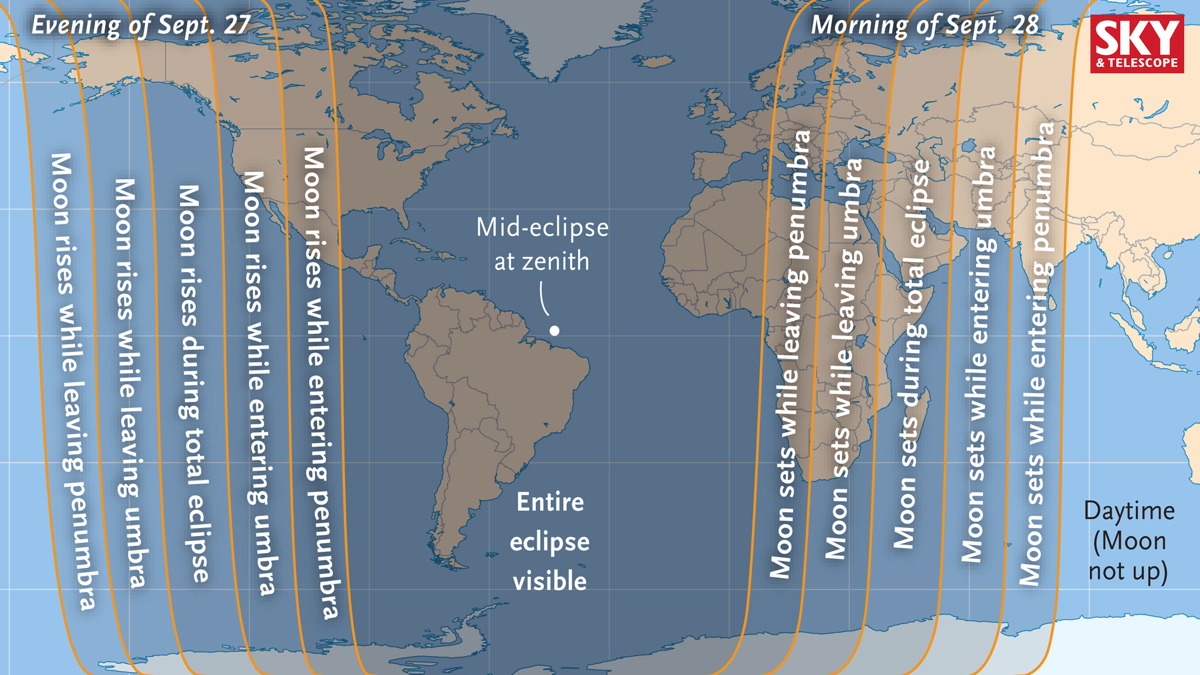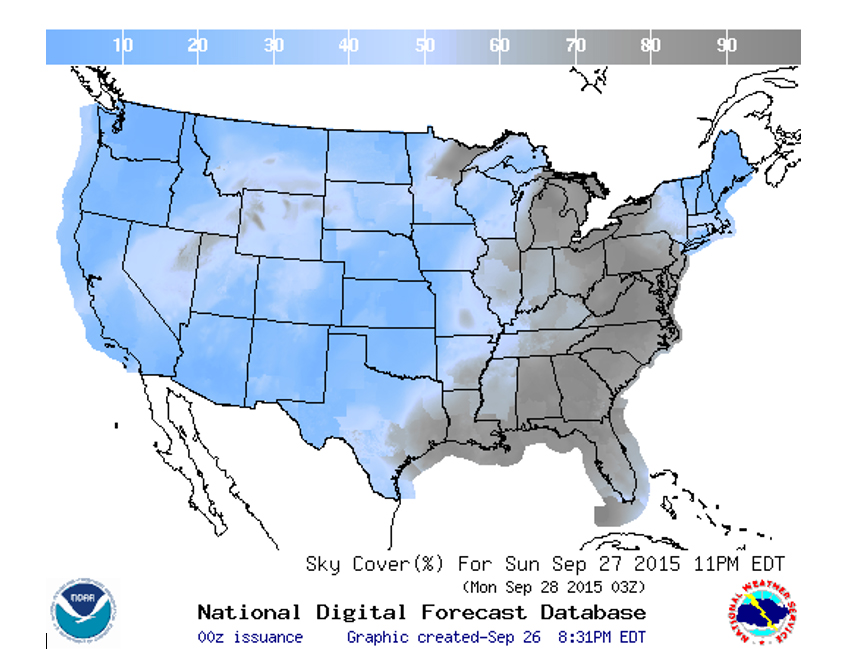
About 70 percent of the country will be able to get a good view of the total lunar eclipse tonight (Sept. 27). Unfortunately for many who live east of the Mississippi River, the odds of seeing the moon as it passes completely into the Earth's shadow are rather poor, according to current weather projections.
Read on below to get our supermoon lunar eclipse weather forecast for skywatchers across the United States. If clouds or bad weather ruins your view, don't fret. You can always watch the lunar eclipse online in a webcast by the Slooh Community Observatory.
You can also see the lunar eclipse webcast on Space.com, courtesy of Slooh. The webcast will begin at 8 p.m. ET (midnight GMT). [Tonight's Total Lunar Eclipse: When and How to See It]

Unsettled for much of Eastern U.S.
At eclipse time, a low pressure system will be located just to the east of the Georgia coast. The storm is forecast to produce scattered showers and possibly a few thunderstorms across parts of the Carolinas, and spotty light rain for Virginia and West Virginia, Maryland, western Pennsylvania and eastern Ohio.
A second low pressure system over the western Gulf of Mexico is forecast to bring a swath of heavier showers and thunderstorms to parts of southeast Texas, as well as portions of the Deep South, Piedmont and Florida. Accompanying this precipitation will be widespread cloud cover extending from the Gulf Coast and Florida, north to the central and eastern Great Lakes. [Visibility Maps for the Lunar Eclipse (Gallery)]
Another area of unsettled and wet weather will be over the "Arrowhead" Region of northeast Minnesota, generated by an approaching cold front.

Alaska and Hawaii
And I haven't forgotten you folks in Alaska and Hawaii. Unfortunately, Alaska will be almost completely clouded over along with areas of rain and showers. Hawaii will not fare much better for those hoping to catch the closing stages of the eclipse. Strong trade winds will keep most showers focused over windward slopes, with showers reaching leeward sides of the smaller islands over the next couple of days. Tropical storm Niala is forecast to pass south of the Big Island Sunday and Monday, and bring heavy rain to the Big Island and surf to east facing shores.
Get the Space.com Newsletter
Breaking space news, the latest updates on rocket launches, skywatching events and more!
Central and West should get a good look; New England too
In contrast, most of the central and western United States, as well as New England and eastern New York State is expected to get a fine view of tonight's total lunar eclipse. A frontal boundary situated over the central Plains and Rocky Mountains could generate some partial cloud cover but not enough to seriously hinder viewing of the eclipse. The Southwest Desert, Pacific Northwest and Californiawill be dry and tranquil … and perfect for viewing the moon show.

Over New England and much of adjacent eastern New York State, the weather will be dominated by a large fair-weather ridge of high pressure centered near Nova Scotia and stretching back to the west into the Northeast U.S. Few or no clouds should be the rule for northern and central New England providing near perfect weather for the lunar eclipse. Over southern New England and eastern New York, some high-to-mid level cloudiness might occasionally drift on by. But these clouds for the most part are not opaque, so the moon might still be visible even when clouds are passing in front of it.
In short, if you live in the Northeast U.S., the farther north and east you go, the better your viewing chances; farther to the west and south, thicker clouds are increasingly more likely to eclipse the eclipse.
A National Weather Service Forecast for You
For the very latest forecast for your local area, here is a link that lists all of the National Weather Service Forecast Offices across the United States, including Alaska, Hawaii and the Pacific Region. Just click on the office that serves your area to get not only the latest weather outlook, but access to local radar and satellite imagery as well: http://www.nws.noaa.gov/organization.php.
Editor's note: If you snap a great photo of the total lunar eclipse tonight want to share it for a possible story or gallery, send images and comments in to managing editor Tariq Malik at spacephotos@space.com.
Joe Rao serves as an instructor and guest lecturer at New York's Hayden Planetarium. He writes about astronomy for Natural History magazine, the Farmer's Almanac and other publications, and he is also an on-camera meteorologist for News 12 Westchester, N.Y.Follow us @Spacedotcom, Facebook or Google+. Originally published on Space.com.
Join our Space Forums to keep talking space on the latest missions, night sky and more! And if you have a news tip, correction or comment, let us know at: community@space.com.

Joe Rao is Space.com's skywatching columnist, as well as a veteran meteorologist and eclipse chaser who also serves as an instructor and guest lecturer at New York's Hayden Planetarium. He writes about astronomy for Natural History magazine, Sky & Telescope and other publications. Joe is an 8-time Emmy-nominated meteorologist who served the Putnam Valley region of New York for over 21 years. You can find him on Twitter and YouTube tracking lunar and solar eclipses, meteor showers and more. To find out Joe's latest project, visit him on Twitter.










